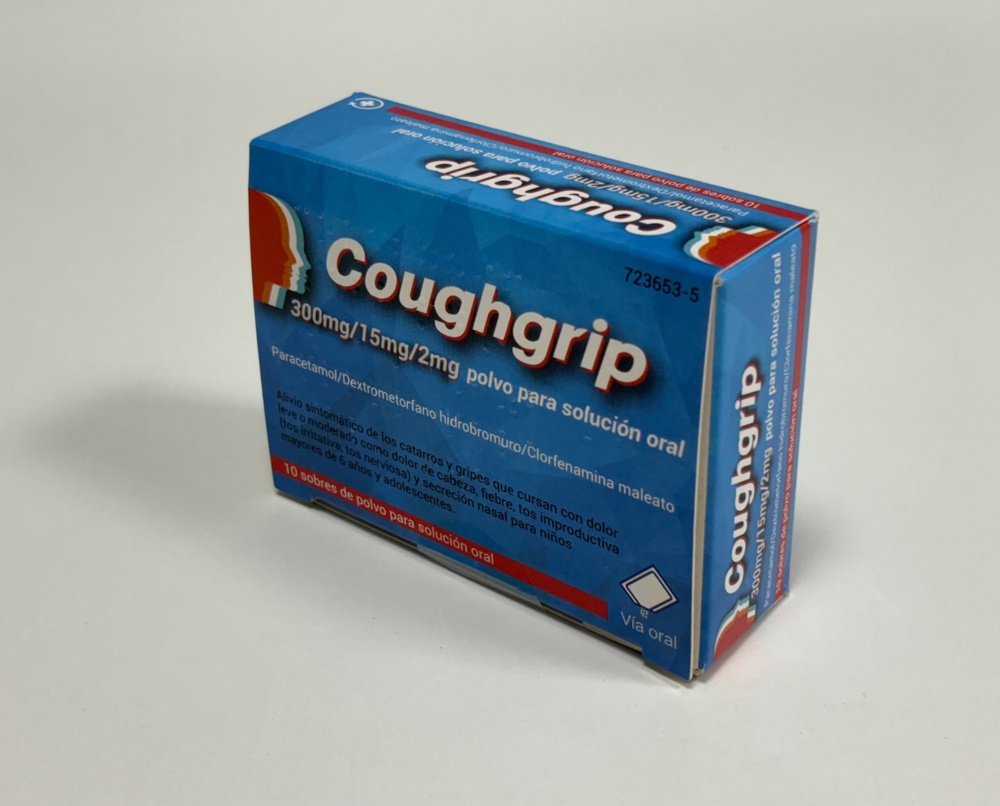

COUGHGRIP 300mg/15mg/2mg ORAL SOLUTION POWDER

Ask a doctor about a prescription for COUGHGRIP 300mg/15mg/2mg ORAL SOLUTION POWDER

How to use COUGHGRIP 300mg/15mg/2mg ORAL SOLUTION POWDER
Introduction
Package Leaflet: Information for the User
Coughgrip 300 mg/15 mg/2 mgpowder for oral solution
Paracetamol / Dextromethorphan hydrobromide / Chlorphenamine maleate
Read all of this leaflet carefully before you start taking this medicine because it contains important information for you.
Follow the instructions for administration of the medicine contained in this leaflet or as indicated by your doctor or pharmacist.
- Keep this leaflet, you may need to read it again.
- If you need advice or more information, consult your pharmacist.
- If you experience side effects, consult your doctor or pharmacist, even if they are not listed in this leaflet. See section 4.
- You should consult a doctor if it worsens or does not improve after 3 days.
Contents of the Package Leaflet
- What is Coughgrip and what is it used for
- What you need to know before you start taking Coughgrip
- How to take Coughgrip
- Possible side effects
- Storage of Coughgrip
- Contents of the pack and further information
1. What is Coughgrip and what is it used for
Paracetamol / Dextromethorphan / Chlorphenamine is an association of paracetamol, an analgesic that reduces pain and fever; dextromethorphan, an antitussive, and chlorphenamine, which helps reduce nasal secretion.
This medicine is indicated for the symptomatic relief of colds and flu that present with mild or moderate pain such as headache, fever, unproductive cough (irritative cough, nervous cough) and nasal secretion for children over 6 years and adolescents.
You should consult a doctor if it worsens or does not improve after 3 days of treatment.
2. What you need to know before you start taking Coughgrip
Do not takeCoughgrip
- If you are allergic to the active substances or to any of the other components of this medicine (listed in section 6)
- If you have severe liver or kidney disease
- If you have respiratory failure or severe lung disease
- If you have asthmatic cough or cough accompanied by abundant secretions
- If you are or have recently been in the last two weeks, under treatment with other medicines, such as those used to treat depression, Parkinson's disease, or other diseases (monoamine oxidase inhibitors (MAOIs), serotonin reuptake inhibitors, such as fluoxetine or paroxetine, or bupropion, which is a medicine to quit smoking, or linezolid, which is an antibiotic (see section "Other medicines and Coughgrip")
- Children under 6 years of age cannot take this medicine.
Warnings and precautions
Consult your doctor or pharmacist before starting to take Coughgrip
- Do not take more than the recommended dose in section 3. How to take Coughgrip
- Chronic alcoholics should be cautious not to take more than 6 sachets per day (2g of paracetamol)
- Avoid simultaneous use of this medicine with other medicines that contain paracetamol, as high doses can lead to liver damage. Do not use more than one medicine that contains paracetamol without consulting your doctor.
- In case of glucose-6-phosphate dehydrogenase (G6PD) deficiency (can cause hemolytic anemia).
The following patients should consult their doctor or pharmacist before starting to take this medicine:
- Patient with persistent or chronic cough, such as that due to smoking. Especially in children, chronic cough could be an early symptom of asthma
- Patient with kidney, heart, or lung disease and patients with anemia
- Patient with liver disease (with or without liver failure) or viral hepatitis, as it increases the risk of hepatotoxicity due to paracetamol
- Patient with asthma sensitive to acetylsalicylic acid
- Patient sensitive (allergic) to an antihistamine, as they may be sensitive to other antihistamines (such as chlorphenamine)
- Patient with hypertension (high blood pressure), glaucoma (high eye pressure), hyperthyroidism, obstruction of the bladder neck, symptomatic prostatic hypertrophy, urinary retention
- Patient of advanced age who may be more sensitive to the side effects of this medicine
- Patient who are sedated, debilitated, or bedridden
- Patient with atopic dermatitis (inflammatory skin disease characterized by erythema, itching, exudation, crusts, and scaling, which begins in childhood in individuals with hereditary allergic predisposition)
During treatment with Coughgrip, inform your doctor immediately:
- If you have severe diseases, such as severe renal failure or sepsis (when bacteria and their toxins circulate in the blood, causing damage to organs), or if you have malnutrition, chronic alcoholism, or if you are also taking flucloxacillin (an antibiotic). A serious disease called metabolic acidosis (an anomaly in blood and fluids) has been reported in patients in these situations when paracetamol is used at regular doses for a prolonged period or when paracetamol is taken with flucloxacillin. The symptoms of metabolic acidosis may include: severe breathing difficulties with deep and rapid breathing, drowsiness, feeling of discomfort (nausea) and vomiting.
This medicine can cause sedation. Avoid consumption of alcoholic beverages and certain medicines while taking this medicine, as they can potentiate this effect. Consult the sections "Other medicines and Coughgrip" and "Taking Coughgrip with food, drinks, and alcohol".
There have been cases of abuse with medicines that contain dextromethorphan in adolescents, therefore, this possibility should be taken into account, as serious side effects can occur (see section: If you take more Coughgrip than you should).
This medicine can also be addictive, so its use at high doses or for a prolonged period can lead to tolerance and mental and physical dependence. In patients with a tendency to abuse or dependence, it will only be administered under strict medical control and for short periods of time.
This medicine can cause dependence. Therefore, treatment should be short-term.
Other medicines andCoughgrip
Tell your doctor or pharmacist if you are taking, have recently taken, or may need to take any other medicine.
You cannot take this medicine if you are being treated with the following medicines, nor in the 2 weeks following treatment, as it can cause excitement, high blood pressure, and fever above 40°C (hyperpyrexia):
- monoamine oxidase inhibitors (MAOIs) (moclobemide, tranylcypromine),
- serotonin reuptake inhibitors (paroxetine, fluoxetine),
- bupropion (used to quit smoking),
- linezolid (used as an antibiotic),
- procarbazine (used to treat cancer),
- selegiline (used to treat Parkinson's disease).
If you are using any of the following medicines, consult your doctor before starting to take this medicine, as it may be necessary to modify the dose of some of them or interrupt treatment:
- Medicines to treat epilepsy: antiepileptics (lamotrigine, phenytoin, or other hydantoins, phenobarbital, methylphenobarbital, primidone)
- Medicines to treat tuberculosis: (isoniazid, rifampicin)
- Medicines to prevent blood clots: oral anticoagulants (acenocoumarol, warfarin)
- Medicines used to increase urine elimination (diuretics such as furosemide, or others), and other diuretics that cause potassium loss (such as diuretics to treat hypertension or others)
- Medicines used to prevent nausea and vomiting (metoclopramide and domperidone).
- Medicines used to treat gout (probenecid)
- Medicines used to treat high blood pressure (hypertension), such as propranolol, and heart rhythm disorders (cardiac arrhythmias), such as amiodarone or quinidine
- Medicines used to lower cholesterol levels in the blood (cholestyramine)
- Medicines used to treat depression (moclobemide, tranylcypromine, fluoxetine, paroxetine, bupropion), Parkinson's disease (selegiline), or other diseases, such as cancer (procarbazine), infections (linezolid, furazolidone). It is recommended to separate the administration of Coughgrip by at least 14 days after finishing treatment
- Other medicines to treat depression, called tricyclic and tetracyclic antidepressants (such as maprotiline)
- Medicines for schizophrenia (such as haloperidol)
- Medicines that cause depression of the central nervous system (such as those used for insomnia or anxiety, for Parkinson's disease, for allergies)
- Ototoxic medicines (which have the adverse effect of damaging the ear)
- Photosensitizing medicines (which have the adverse effect of causing allergy to light)
- Medicines used to relieve pain and inflammation (celecoxib, parecoxib, valdecoxib)
- Medicines used to increase mucus secretion.
- Flucloxacillin (antibiotic), due to a serious risk of blood and fluid anomaly (called metabolic acidosis) that requires urgent treatment (see section 2).
Interference with analytical tests:
If you are going to undergo any diagnostic test (including blood tests, urine tests, skin tests that use allergens, etc...), inform your doctor that you are taking this medicine, as it may alter the results.
Consult your doctor or pharmacist before taking Coughgrip:
If you are taking other medicines such as antidepressants or antipsychotics, Coughgrip may interact with these medicines and you may experience changes in your mental state (e.g., agitation, hallucinations, coma) and other effects such as body temperature above 38°C, increased heart rate, high blood pressure, and exaggerated reflexes, muscle stiffness, lack of coordination, and/or gastrointestinal symptoms (e.g., nausea, vomiting, and diarrhea).
TakingCoughgripwith food, drinks, and alcohol
While taking this medicine, you cannot drink alcoholic beverages, as it can potentiate the appearance of side effects of this medicine.
Additionally, the use of medicines that contain paracetamol by patients who habitually consume alcohol (3 or more alcoholic drinks: beer, wine, liquor,... per day) can cause liver damage.
Do not take the medicine with grapefruit or bitter orange juice, as it can potentiate the effects of one of its components (dextromethorphan).
The rest of the food and drinks can be taken with this medicine, as they do not affect its efficacy.
Pregnancy, breastfeeding
If you are pregnant or breastfeeding, think you may be pregnant, or plan to become pregnant, consult your doctor or pharmacist before using this medicine.
This medicine should not be taken during pregnancy or breastfeeding without consulting your doctor
Driving and using machines
This medicine can cause drowsiness, altering mental and/or physical ability. If you notice these effects, avoid driving vehicles or using machines.
Coughgripcontains sucrose and sodium:
This medicine contains sucrose. If your doctor has told you that you have an intolerance to certain sugars, consult with them before taking this medicine.
This medicine contains less than 23mg of sodium (1mmol) per sachet; this is, essentially "sodium-free".
3. How to take Coughgrip
Follow the instructions for administration of the medicine contained in this leaflet or as indicated by your doctor or pharmacist. In case of doubt, ask your doctor or pharmacist.
Pediatric population
Severe side effects can occur in children in case of overdose, including neurological disorders. Caregivers should not exceed the recommended dose.
The powder contained in the sachets of Coughgrip is for oral administration.
The recommended dose is:
Children from 6 to 12 years (weight between 21.5 kg and 43 kg): 1 sachet every 6-8 hours as needed (3 or 4 times a day).
Over 12 years (weight over 44 kg): 2 sachets every 6-8 hours (3 or 4 times a day) as needed.
Preferably take 1 dose before bedtime. Do not exceed 4 doses.
This medicine is contraindicated in children under 6 years.
Always use the lowest effective dose.
Start treatment when the first symptoms appear and stop as they disappear.
The medication should not be used for more than 3 consecutive days without consulting a doctor (see section 1 What is Coughgrip and what is it used for).
How to take:
This medicine is taken orally.
Pour the contents of a sachet into a half glass of water and stir vigorously. Take immediately.
If you take moreCoughgripthan you should
Go immediately to a medical center, even if you do not have symptoms, as they often do not appear until 3 days after ingestion of the overdose, even in cases of severe poisoning.
The most serious effect of overdose of this medicine is liver damage caused by paracetamol. You may feel dizzy, vomit, confused, excited, restless, nervous, irritable, visual disturbances, loss of appetite, yellowing of the skin and eyes (jaundice), abdominal pain, and difficulty breathing. In children, states of drowsiness, nervousness, nausea, vomiting, or alterations in gait.
Treatment of overdose is most effective if started within 4 hours of ingestion of the medicine.
Patient under treatment with barbiturates or chronic alcoholics may be more susceptible to the toxicity of a paracetamol overdose.
There have been cases of abuse with medicines that contain dextromethorphan, which can cause serious side effects, such as: anxiety, panic, memory loss, tachycardia (acceleration of heartbeats), lethargy, hypertension or hypotension (high or low blood pressure), mydriasis (dilation of the pupil), agitation, vertigo, gastrointestinal disorders, slurred speech, nystagmus (involuntary and uncontrolled movement of the eyes), fever, tachypnea (shallow and rapid breathing), brain damage, ataxia (uncoordinated movements), convulsions, respiratory depression, loss of consciousness, arrhythmias (irregular heartbeats), and death.
In case of overdose or accidental ingestion, consult your doctor or pharmacist immediately or call the Toxicology Information Service, phone: 91 562 04 20, indicating the medicine and the amount taken. It is recommended to bring the packaging and the package leaflet of the medicine to the healthcare professional.
If you take more Coughgrip than indicated, you may experience the following symptoms: nausea and vomiting, involuntary muscle contractions, agitation, confusion, drowsiness, disorders of consciousness, rapid and involuntary eye movements, cardiac disorders (acceleration of heart rate), coordination disorders, psychosis with visual hallucinations, and hyperexcitability.
Other symptoms in case of massive overdose may be: coma, severe respiratory problems, and convulsions.
Overdose can also cause: coagulation disorders (blood clots and bleeding).
Contact your doctor or hospital immediately if you experience any of the mentioned symptoms.
4. Possible side effects
Like all medicines, this medicine can cause side effects, although not everyone gets them.
The most common side effects are sedation and drowsiness.
During the use of the association of paracetamol, dextromethorphan, and chlorphenamine, the following side effects have been reported, whose frequency cannot be established with accuracy.
Rarely, nightmares, insomnia, excitement, nervousness, or restlessness (hyperactivity) can occur, more common in children and the elderly. Dizziness and hypotension, especially in the elderly.
Very rarely, gastrointestinal disorders, such as abdominal pain, diarrhea, nausea, vomiting, and indigestion (dyspepsia), confusion, dizziness, visual disturbances, increased sensitivity to the sun, dry mouth, sore throat, and difficulty urinating. Also, skin rashes, severe skin reactions, and severe allergic reactions, such as anaphylactic reaction, hypersensitivity, angioedema (swelling of certain areas of the skin), pruritus, urticaria, rash, allergic dermatitis, as well as increased transaminases. High doses or prolonged treatments are toxic to the liver.
Frequency not known (cannot be estimated from the available data): A serious disease that can make the blood more acidic (called metabolic acidosis) in patients with severe disease who use paracetamol (see section 2).
Other side effects in children
Taking very high amounts of this medicine can cause children to experience a state of drowsiness, nervousness, nausea, vomiting, or alterations in gait.
Simultaneous consumption of alcohol during treatment can accentuate the appearance of side effects. Do not ingest alcoholic beverages during treatment.
Reporting of side effects
If you experience any type of side effect, consult your doctor or pharmacist, even if it is a possible side effect that does not appear in this leaflet. You can also report them directly through the Spanish Pharmacovigilance System for Human Use Medicines: www.notificaRAM.es. By reporting side effects, you can contribute to providing more information on the safety of this medicine.
5. Storage of Coughgrip
Keep this medicine out of the sight and reach of children.
Do not use this medicine after the expiration date that appears on the packaging, after CAD. The expiration date is the last day of the month indicated.
No special storage conditions are required
Medicines should not be disposed of via wastewater or household waste. Deposit the packaging and medicines you no longer need at the SIGRE point in your pharmacy. Ask your pharmacist how to dispose of the packaging and medicines you no longer need. This will help protect the environment.
6. Package Contents and Additional Information
Composition ofCoughgrip
Each sachet contains:
- The active ingredients are: 300 mg of paracetamol, 15 mg of dextromethorphan (as hydrobromide) and 2 mg of chlorphenamine (as maleate).
- The other components (excipients) are: anhydrous colloidal silica, anhydrous citric acid, sucrose, sodium saccharin, anhydrous sodium cyclamate, orange flavor.
Appearance of the Product and Package Contents
Coughgrip is a white or yellowish-white oral solution powder with an orange flavor, presented in sachets packaged in cardboard boxes containing 10 sachets.
Marketing Authorization Holder and Manufacturer
Marketing Authorization Holder
Tecnimede España Industria Farmacéutica, S.A.
Avda. de Bruselas, 13. 3º D
28108 Alcobendas (Madrid)
Spain
Manufacturer
Laboratorios Alcalá Farma, S.L.
Avenida de Madrid, 82
28802 Alcalá de Henares Madrid
Spain
Date of the Last Revision of this Leaflet:February 2025
Detailed and updated information on this medicine is available on the website of the Spanish Agency for Medicines and Health Products (AEMPS) http://www.aemps.gob.es/
- Country of registration
- Prescription requiredNo
- Manufacturer
- This information is for reference only and does not constitute medical advice. Always consult a licensed doctor before taking any medication. Oladoctor is not responsible for medical decisions based on this content.
- Alternatives to COUGHGRIP 300mg/15mg/2mg ORAL SOLUTION POWDERDosage form: ORAL SOLUTION/SUSPENSION, 7 mg/mlActive substance: Hederae helicis foliumManufacturer: Engelhard Arzneimittel Gmbh & Co. KgPrescription not requiredDosage form: EFFERVESCENT TABLET, 600 mgActive substance: acetylcysteineManufacturer: Kern Pharma S.L.Prescription not requiredDosage form: EFFERVESCENT TABLET, 600 mgActive substance: acetylcysteineManufacturer: Laboratorios Alter S.A.Prescription required
Online doctors for COUGHGRIP 300mg/15mg/2mg ORAL SOLUTION POWDER
Discuss dosage, side effects, interactions, contraindications, and prescription renewal for COUGHGRIP 300mg/15mg/2mg ORAL SOLUTION POWDER – subject to medical assessment and local rules.














